First practical example: Unto the House of the Lord
Starting point: a melody with chords of this piece.
I chose to write in D major (original is in F major). To get back to the original key I will have to move my fretboard to the III position so I will have to take this into account when choosing fingers positions.
Needless to say that all the examples are thought with F# and C# in the key
First bar has two eigth in F and two in C, that is, after transposition, D and A.
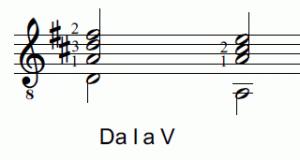
I watched my "handbook" and I have found the passage from I degree (D) to V (A):

I chose a really simple arpeggio and here is the way I proposed it: (cf. score):
The following passage is to a G minor (transposed it becomes E minor), and here it is the first trouble. In my "handbook" this passage is not present. This is the reason: following the classical harmony rules, as the V degree has the leading-tone (A#) you have the obligation of resolving it to the tonic (D). But in the E minor chord there is not the D note, neither you can insert the seventh as it should be prepared (that is D should be present in the previous chord).

To escape this situation I opened my "handbook" of the C key and I looked the passage from A minor to E minor (same notes but without the alteration of C) and I found:

So this is how the arpeggio has been carried out:

Now we have a Bb (that is a G after transposition), so, looking back to the D major "handbook", I could find:
One more difficulty: the starting position is different and so this seems a useless sign. Yet, looking deeper, we simply have a G moved of an eigth.

As that G doesn't move in the passage
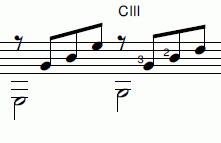
moving it down of an eigth cannot create harmonic errors (a "still" note never creates harmonic errors), so the passage has become:

The following passage too has a similar issue, indeed it is:
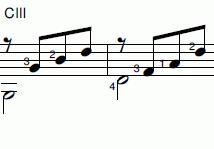
The adopted solution is the same as before, moving of an eigth the starting G and the corresponding F#.
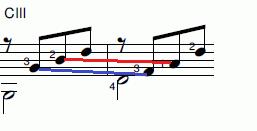
In this case harmonic correctness is not automatic, we created a paralell movement from G-B of the first chord and F#-A of the second chord.
As it is a movement of parallel third it is admitted.
Also in the following passage we have to modify something. It is a I - V movement again (as the very first one) but in a different starting position.
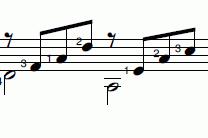
We have resolved it moving the passage F#-E of an eigth
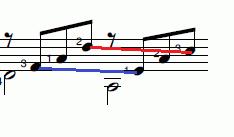
Like before, let's verify that we didn't added harmonic errors. We have a passage from the interval F#-D to E-C#
This is a parallel sixth movement that doesn't create errors.
As now we are in positions lower than usual, in the following passage we will try to get more common positions for the chords.

It is again a V - II passage and this time we will resolve it like this:

There is a movement from the E-A interval to a G-B,
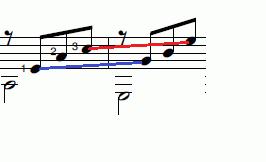
That is a similar motion from an interval of fourth to a third (no problem), a parallel motion of sixth from E-C# to G-E

and neither this is a problem, and a similar motion from A-C# to B-E
that is a motion from a third to a interval of fourth (and this doesn't create errors).
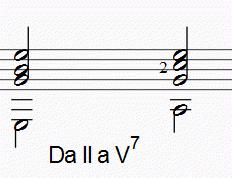
The following passage is from E minor to A7
As it is the last chord of the first phrase, if we want to use again the beginning chord we need that the A7 - D passage lead to the same position as the beginning of the piece.
The imperative for the seventh to resolve stepping down lead to the need for G to be in such a position so to have the F# as its resolution.

Summarizing, if I took the position presented above, the chord after D should be
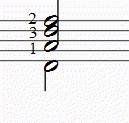
but as I need to get back to this position of the D chord

I will have to arrange the seventh in this position

This way the passage becomes
The movement of all the voices in similar mode creates big risks to have errors, but, having avoided the fifth of the chord (the E) I can reach a not graceful but correct solution. Let's see in detail.

Starting from the bass voice, the interval of third (E-G) become an eigth (A-A)
it would be an hidden eigth case bur it is tolerated as one voice (the tenor) has a step motion (that is it is moving of a second - G-A in this instance).
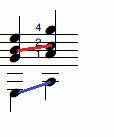
The interval of fifth E-B resolves without errors on the interval third A-C#,

the eigth interval E-E resolves without errors on a interval of seventh (A-G).
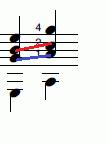
Starting from the tenor voice, the interval of third G-B goes in parallel on another third interval A-C#
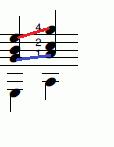
(no errors), the interval of sixth G-E moves to an interval of seventh A-G.
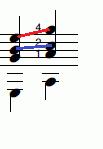
At last, the interval of fourth B-E has a similar motion to an interval of fifth C#-G
In this case too we have no errors as the Alto voice has a step motion and avoids an hidden fifth error.
Bar 5 is the same as bar 1 but the passage at bar 6 has been modified so that we will arrive at the A7 of bar 7 in a better position.

So, the passage V - II (we have already discuss on it) has been solved in this way:
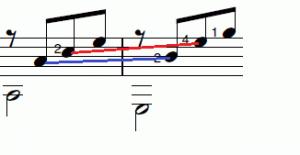
The similar motion passage are: from a third (A-C#) to a fourth (B-E) passage,
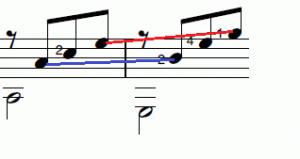
No problem, from a fifth (A-E) to a sixth (B-G),

ok, and from a third (C#-E) to a third (E-G).
Everything alright.

The next passage has been taken from the "handbook":

And it has been resolved in this way:

This time the G-D passage is as described

and it becomes

Now we have a passage to A7, that is:

and we take it as it is
Please note that also in this case we avoided the fifth (E) from the A7 chord. The passage from A7 to D was already described above and it has not been modified.
The second strophe starts with a D and the first passage to A is the same as for the first bar.

At bar 14there is a movement in position between A and A that does not create problems for the interval of third A-C# goes with similar motion to the third C#-E,

The interval of fifth A-E goes for similar motion to the interval of sixth C#-A

and finally the interval of third C#-E moves with similar motion to the interval of fourth E-A.
Everything's alright.

Immediately after, again a passage V - II but in a different befinning position. Starting from the previous indication

In this case we resolve moving the A and the G at the upper eigth in this way:

We have only to verify the similar motion between a sixth (C#-A) and another sixth (B-G).
It's alright.

The next passage E minor - G has already been presented at bar 6. Following a passage G-A that we can take from our "handbook"

We resolve it in this way:
Finally a passage A-A7 in which only one note moves (so there cannot be errors) and the joint with the first bar with a passage A7 - D as in bar 7.

The coda shows a passage D - E minor that follows these indications:

And it is resolved:

Then there is a passage where only the bass moves of an eigth and then a passage from E minor to G that is the same as bar 2, from G to D as between bar 2 and bar 3 and at last an harmonic passage on D in which the interval of third F# - A goes in similar motion to the interval of fourth A - D,

The interval of sixth F# - D goes in parallel motion to the sixth A - F#

And the interval of fourth A - D goes with similar motion to the interval of third D - F#
finishing the whole without errors (at least I hope !)
Second practical example: Svegliati, o Sion

Analysis
Here is the first bar of what I think is the official harmonization:

It is a six eight tune harmonized with two chords per bar. The first bar is made by a couple of G major (the tonality of the piece). The notes outside the chord are steps on weak beats.
The secon bar is as follows:
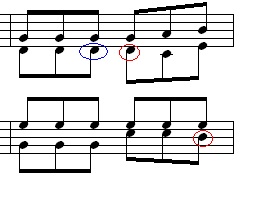
that is a C major (IV degree of G) at first complement and a D major (V).
The next one:
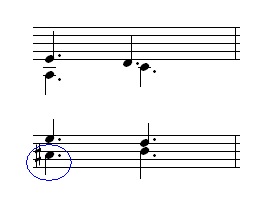
that is a G chord (I), first inversion and a E minor 7th (II). The seventh (the 2 D rounded in red) is present in the previous chord in the same position (blue circle) and it is moved from Alto to Bass to have a resolution in the bass itself in the next bar:
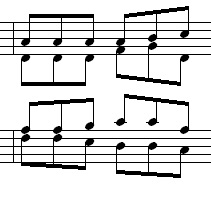
The chord are A major seventh and D seventh (V). The C sharp in the bass voice is the resolution of the previous E minor seventh. The alteration is a temporary tonal variation called "counterdominant" that is the dominant of the dominant. Indeed, the dominant of G is D and the dominant of D is A, the dominant chord is always major. Please, note that the G of the A 7 was already present in the E minor chord of the previous bar (prepared seventh) and resolves in the F sharp of the next chord (tenor). The seventh of the dominant (the C, natural) has not to be prepared and will resolve two bars later (in a little bit elaborated way) on the B in the bass voice after a movement. The next bar:

is made by a D chord (V) and then by a D 7, pratically it moves the seventh at first to the tenor then to the bass. Going on

we found a G chord at first complement (I) and a C (IV). Going on:
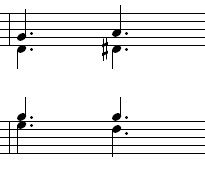
a G (I) again in second inversion and a C (IV) with seventh and nineth. The nineth (D in the bass voice) has a preparation but not a resolution, the seventh (B in the soprano voice) is somehow prepared by the B of the tenor and then (maybe) will resolve again in the tenor voice.
In the end, the last bar of the refrain:
has a G (I) chord and a B seventh at second complement, that is a modulation to E minor, a little bit abrut but that is so. The seventh is not prepared because B us the dominant of the new tonality. It would be better to resove it (but in the score in my possesion the harmonization of the verses is missing).
A possible harmonic solution with the same chords and respecting the main rules, could be as follows:

and a simple arpeggio could be a solution as it follows:


